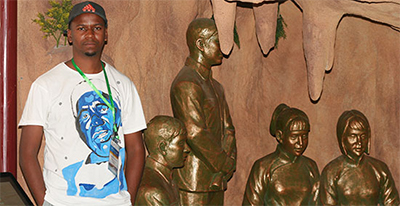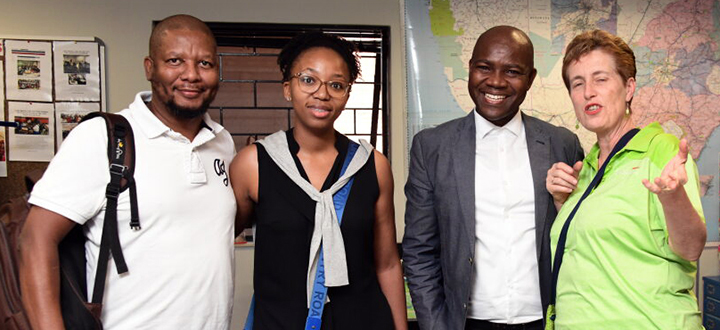

Luyanda Noto (Postdoctoral Fellow: Department of Physics, Unisa) attended the BRICS Young Scientist Forum in China this year. He is pictured here standing next to a display at the Chinese Cave Library.
Ten young South African scientists and three senior researchers were nominated by the Academy of Science of South Africa (ASSAf) to attend the second BRICS Young Scientist Forum in Hang Zhou, China, earlier this year. One of them was Dr Luyanda Noto, postdoctoral Fellow in Unisa’s Department of Physics.
Noto’s potential was introduced to ASSAf when he applied and got selected to attend the annual Lindau Nobel Laureate Meeting, in Germany. There he was nominated from the 400 candidates who were attending the meeting to visit the universities of Baden-Wurttemberg, a state in Germany, in light of future collaboration, where Noto represented the entire African continent. “This may have led to them advocating my nomination to the Minister of Science and Technology of South Africa,” he explained.
With his research speciality in condensed matter physics, focusing on persistent luminescence materials for home lighting that do not require electrical connection, and up-converted luminescence to enhance the efficiency of solar cells, BRICS was a dream come true for this young scientist.
Noto has many highlights from the trip. The BRICS Young Scientist Forum included presentations from young and established scientists from the five BRICS countries, which were in Materials Science, Energy, and Biotechnology. The presenters from all countries showed tremendous achievements in their respective fields, indicating that all countries are keenly moving forward in advancing science. “I admired the cultural depth of the Chinese people and their pride to be who they are, and their strong discipline which I observed from the elite to the taxi drivers. The continuous infrastructural development of the city of Hangzhou clearly indicates the position of the Chinese government in positioning their country as a leading country across the globe. We had time to visit the science and engineering and architectural building, which showcased Chinese science history and new developments,” he said.

Robotics was one of the aspects that interested Noto at BRICS. This shows a fascinating robotic project by a first year student of a dog-like moving prototype.
For Noto, it was fascinating to observe the robotic developments that came from students in the first year’s class of their undergraduate studies, which equate to master’s projects in South Africa. “The building showcased the academic history of the Chinese people and how they fought for their descendants to be educated, to an extent that they hid books and educated their children in caves during an attack by the Japanese and the British, who wanted to limit the literacy of the Chinese people. Whilst visiting the laboratories of Zhejiang University at the Department of Polymer and Materials Sciences, we discovered that first year undergraduate students participate in product development research of different textiles, glass fabrication, Li-Ion battery development, etc,” he explained.
In addition to soaking up the science aspect of this trip, Noto was equally keen when it came to Chinese culture. “Upon visiting their flea markets in the evenings after the sessions, I was fascinated by the display of Chinese culture, which proved to be paving their daily lives, and I found people there to be friendly and accommodative. Even though the language was a barrier, we could somehow connect and find each other when we are communicating.”
This joint venture with ASSAf and the Department of Science and Technology saw talented young scientists attend the forum themed Building young scientists’ leadership in science, technology, and innovation. Around 200 delegates from across the BRICS nations attended the forum.
The forum comprised four thematic areas: energy, material, biotechnology, and biomedicine, as well as one cross-cutting field of science, technology and innovation policies, science communication, and science popularisation.
The forum provided a high-level platform of academic and policy exchange for young scientists as well as scientific personnel from BRICS countries to help them grow their skills and improve academic and policy qualifications.
*By Kirosha Naicker
Publish date: 2017/10/06